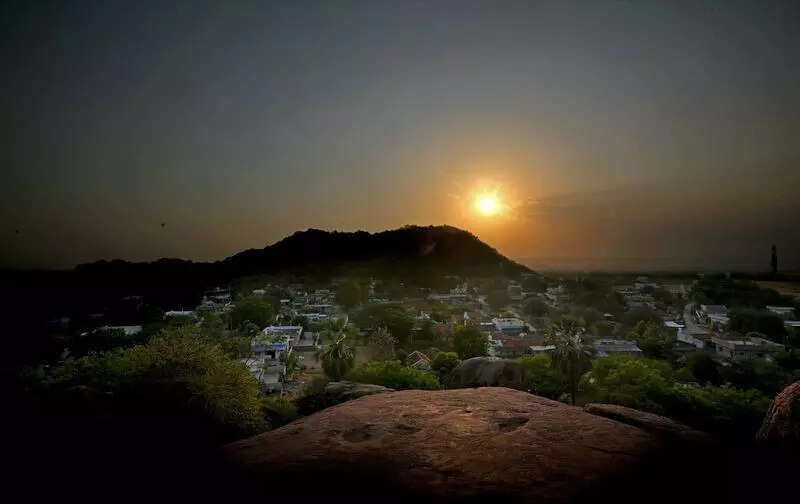Where the sun clocks out early | Hyderabad News

Hyderabad: While American author Kristen Butler’s quote, “Sunsets are proof that no matter what happens, every day can end beautifully,” resonates universally, residents of a particular Telangana village experience their daily sunset one to two hours earlier than usual.The explanation lies in straightforward geography rather than any mysterious or scientific phenomenon. The distinctive topography of Kodurupaka village, encompassed by three hills in Peddapalli district, around 200 km from Hyderabad, creates a unique daylight pattern. This natural setting has influenced how its residents structure their daily activities, a practice maintained across generations, distinguishing it from other neighbouring settlements in Telangana. Known as ‘Moodu Jaamula Kodurupaka’ (Three time periods – morning, afternoon & night) by locals, the village’s fascinating geography, with a population of over 1,000, has even transformed it into a destination for visitors. When the sun descends behind ‘Ranaganayakula gutta’, one of these hills, its shadow envelops the village at 4 pm, creating darkness equivalent to what one typically experiences at 6 pm. In fact, the settlement’s reduced daylight hours are characterised by a sunrise delayed by 30 minutes and a premature sunset. Upon visiting this village and ascending the hill facing Ranganayakula gutta at sunset, STOI observed that while the neighbouring areas remain bright, Kodurupaka falls into slight darkness due to the shadows cast by the hills. The early darkness affects the village residents, especially children, who find their evening activities curtailed during winter and monsoon seasons, as the shadow from the hills sets in between 3.30 pm and 4 pm. “As evening approaches, the Narasimha Swamy temple is the first to experience the shadow, which then gradually spreads to other houses in the village. The pattern of nightfall here differs noticeably from surrounding villages,” said Mallesham, who works in Kodurupaka Grama Panchayat. “The presence of an eastern hill affects the timing of sunrise in this area. Throughout summer, sunrise occurs 15 minutes later than expected, while during winter and monsoon periods, daylight only emerges after 7 – 7.30 am,” he explained. Lights on by 5 pm As the village, situated alongside the hills facing west, experiences early darkness, the residents need to turn on their lights by 5 pm as their homes become dark when the hills block the sunlight. The street illumination also begins earlier than usual, with lamps being switched on by 5.30 pm. In contrast to neighbouring villages, where people rely on natural daylight for their daily activities, including meal preparation around 5 pm, the inhabitants here must depend on LED lights. While strolling through the neighbourhood around 6 pm in the scorching summer heat, STOI observed children engaged in games near the streetlights. Upon conversing with these children, they mentioned that during November – February, they gather to play beneath the illuminated streetlights as early as 5 pm. “Our place is encircled by villages such as Nimmanpally, Narayanapur, Lokapeta, and Muppidithota, where illumination begins only after 6 pm, with some locations starting as late as 7 pm in the summer months,” said B Rohit, who hails from Kodurupaka but works at an automotive manufacturing unit in Vijayawada. “When you climb the hill and look around you see contrasting illumination patterns, with neighbouring villages lit by bright sunlight while our village appears dark with reduced visibility due to the hills casting shadows. This is particularly noticeable from July to February,” added Rohit, who confesses to missing the captivating views from the hills.He also fondly remembers his childhood when his school classmates from neighbouring villages would inquire about his village’s distinctive features and regard him with special attention.Villagers return from fields by 4 pm As the sun starts casting its last rays from around 4 pm, residents of Kodurupaka return from their agricultural and daily labour to attend to their household tasks. Unlike neighbouring villages where women typically sweep their verandas around 6 pm, in Kodurupaka, this activity can be observed between 4 – 4.30 pm. “The early onset of darkness impacts daily routines in this westward-facing hillside village. Children must complete their outdoor play and homework before the early dusk settles in. Farmers adjust their schedules, wrapping up their tasks well before sunset. Residents have developed a unique rhythm, synchronising their daily chores with the available sunlight,” said T Sridhar Rao, a villager.
















